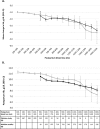How well do postpartum blood loss and common definitions of postpartum hemorrhage correlate with postpartum anemia and fall in hemoglobin?
- PMID: 31437195
- PMCID: PMC6705817
- DOI: 10.1371/journal.pone.0221216
How well do postpartum blood loss and common definitions of postpartum hemorrhage correlate with postpartum anemia and fall in hemoglobin?
Abstract
Objective: We aimed to better understand how well postpartum blood loss and common postpartum hemorrhage (PPH) definitions (i.e. blood loss ≥500ml = PPH, ≥1000ml = "severe" PPH) correlate with postpartum anemia and fall in hemoglobin.
Methods: Secondary analysis of data from three randomized trials that objectively measured postpartum blood loss and pre- and post-delivery hemoglobin among vaginal deliveries: one trial included 1056 home-births in Pakistan and two multi-country hospital-based trials included 1279 women diagnosed with PPH. We calculated Spearman's correlation coefficients (rs) for blood loss with hemoglobin drop and postpartum hemoglobin, and we compared PPH blood loss markers (≥500ml, ≥1000ml) with large hemoglobin drops (≥2 g/dL) and the threshold for moderate postpartum anemia (<10g/dL).
Results: In the Pakistan study and the multi-country trials, blood loss was weakly correlated with hemoglobin drop (Pakistan: rs = -0.220, multi-country trials: rs = -0.271) and postpartum hemoglobin (Pakistan: rs = -0.220, multi-country trials: rs = -0.316). In both the Pakistan and multi-country trials, hemoglobin drop ≥2 g/dL occurred in less than half of women with 500-999 ml blood loss (55/175 [31%] and 302/725 [42%], respectively) and was more common among women who bled ≥1000ml (19/28 [68%] and 347/554 [63%], respectively). Similarly, in the Pakistan and multi-country trials, postpartum anemia <10 g/dL was less frequent among women who bled 500-999 ml (55/175 [31%] and 390/725 [54%], respectively) and more frequent among women with ≥1000ml blood loss (20/28 [71%] and 416/554 [75%], respectively).
Conclusions: Postpartum morbidity as measured by hemoglobin markers was common for women with blood loss ≥1000ml and relatively infrequent among women with blood loss 500-999ml. These findings reinforce the importance of severe PPH as the preferred outcome to be used in research. The weak correlation between blood loss and hemoglobin markers also suggests that this relationship is not straightforward and should be carefully interpreted.
Conflict of interest statement
The authors have declared that no competing interests exist.
Figures

References
-
- WHO. WHO recommendations for the prevention and treatment of postpartum haemorrhage Geneva: Dept. of Reproductive Health and Research, WHO, 2012. ISBN: 978 92 4 154850 2.
-
- Arulkumaran S, Mavrides E, Penney GC. Prevention and management of postpartum haemorrhage Guideline. London, UK: Royal College of Obstetricians and Gynaecologists, 2009. 11 May 2009. Report No.: 52.
-
- Newton M, Mosey LM, Egli GE, Gifford WB, Hull CT. Blood loss during and immediately after delivery. Obstet Gynecol. 1961;17:9–18. Epub 1961/01/01. . - PubMed
Publication types
MeSH terms
Substances
LinkOut - more resources
Full Text Sources
Medical

